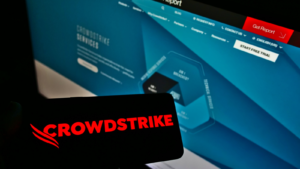
Cybersecurity stocks have been heating up of late as investments in the field are of utmost importance in this data-driven age.
As generative artificial intelligence (AI) capabilities get stronger, so too could the powers of sophisticated cyber attackers. Although gen AI can be used to make our lives easier and more productive, the powerful tools can also get into the wrong hands. That’s a major concern for everybody.
Fortunately, the top cybersecurity firms are ready to fortify client defenses. As cyber threats begin to rise from left, right and center, I’d look for the cybersecurity industry heavyweights to begin attracting more share of the hot market, which could become even more scorching as the fear of AI-augmented cyber threats rises with every major advancement in open-source AI.
Let’s check in on three cybersecurity stocks that I expect will do well as they aim to keep their defenses up to speed.
CrowdStrike (CRWD)

CrowdStrike (NASDAQ:CRWD) earnings came in pretty hot (quarterly sales surged 33% year over year to $845.3 million), as results demonstrated that clients aren’t looking to cut too deeply when it comes to cybersecurity. Indeed, there is just way too much on their plate to cut back on platforms like CrowdStrike’s Falcon.
Moving ahead, there are reasons to believe that CrowdStrike’s cloud security, threat intelligence and endpoint protection services could continue to boom. With gen AI moving at breakneck speed, enterprises will realize the importance of sticking with the best-in-breed security platforms. As CrowdStrike continues investing in its own line of AI-driven tools, look for the $78 billion titan to keep on winning new customers over the medium term.
In a way, the cybersecurity companies, led by CrowdStrike and others, could be the AI plays deserving more respect. Even after the post-earnings bounce, CRWD stock isn’t much higher than its 2021 peak (around 14% above the level).
Fortinet (FTNT)

Fortinet (NASDAQ:FTNT) is another intriguing cybersecurity play that appears far cheaper than CRWD stock, with shares going for just under 49 times trailing price-to-earnings.
Undoubtedly, the $54.4 billion firm has been fluctuating wildly of late after briefly touching all-time highs just shy of $79 back in July 2023. The stock recently got slapped with a big Wells Fargo analyst downgrade, as demand came in a tad on the soft side.
As a smaller player on the scene, Wells Fargo sees competitive pressures from much larger rivals. Indeed, fortune could favor the giants in the cybersecurity scene. Additionally, CrowdStrike — also larger than Fortinet — looks well-equipped
Either way, I wouldn’t sleep on Fortinet as it looks to ramp up investment, with a new $30 million tech hub to be built in the province of Alberta. Indeed, tapping into Canadian tech talent may be what Fortinet needs to kick things up a notch.
Palo Alto Networks (PANW)

Finally, we have Palo Alto Networks (NASDAQ:PANW), perhaps the biggest and best cybersecurity company to own for the long haul. The stock is fresh off a nasty plunge, now off around 26% from its February 2024 peak. A bit of “spending fatigue” may have hit the firm, as management recently remarked. But I think the whole situation is a tad overblown, especially given its clients cannot afford not to spend on the latest and greatest AI-powered offerings.
The company’s intriguing cloud security Prisma and machine learning-powered WildFire services are some of the most capable in the industry.
Moving ahead, I’d look for the firm’s AI prowess to help it win more share of an industry that may be in for a re-acceleration of growth. Even with such robust AI prospects, the stock isn’t exactly expensive, going for just 43.3 times trailing price-to-earnings.
As more hacks hit big firms, look for Palo Alto to be one of the bigger winners as more firms look to upgrade their cybersecurity defenses with the very best in what the market has to offer.
On the date of publication, Joey Frenette did not hold (either directly or indirectly) any positions in the securities mentioned in this article. The opinions expressed in this article are those of the writer, subject to the InvestorPlace.com Publishing Guidelines.




